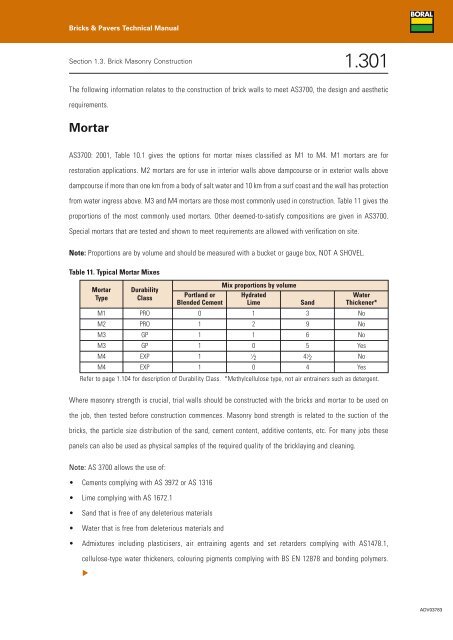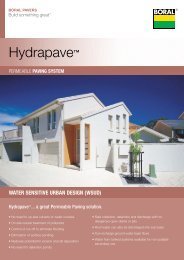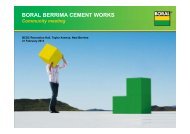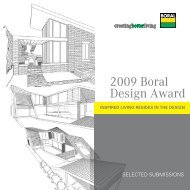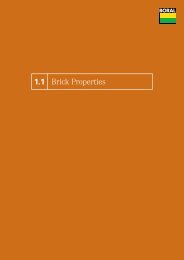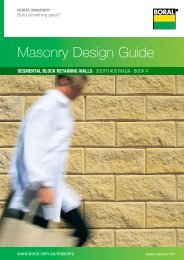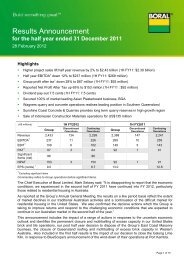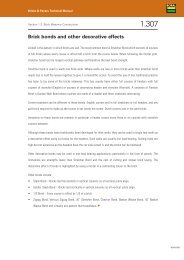Bricks & Pavers Technical Manual - Boral
Bricks & Pavers Technical Manual - Boral
Bricks & Pavers Technical Manual - Boral
You also want an ePaper? Increase the reach of your titles
YUMPU automatically turns print PDFs into web optimized ePapers that Google loves.
<strong>Bricks</strong> & <strong>Pavers</strong> <strong>Technical</strong> <strong>Manual</strong><br />
Section 1.3. Brick Masonry Construction 1.301<br />
The following information relates to the construction of brick walls to meet AS3700, the design and aesthetic<br />
requirements.<br />
Mortar<br />
AS3700: 2001, Table 10.1 gives the options for mortar mixes classified as M1 to M4. M1 mortars are for<br />
restoration applications. M2 mortars are for use in interior walls above dampcourse or in exterior walls above<br />
dampcourse if more than one km from a body of salt water and 10 km from a surf coast and the wall has protection<br />
from water ingress above. M3 and M4 mortars are those most commonly used in construction. Table 11 gives the<br />
proportions of the most commonly used mortars. Other deemed-to-satisfy compositions are given in AS3700.<br />
Special mortars that are tested and shown to meet requirements are allowed with verification on site.<br />
Note: Proportions are by volume and should be measured with a bucket or gauge box, NOT A SHOVEL.<br />
Table 11. Typical Mortar Mixes<br />
Mix proportions by volume<br />
Mortar Durability<br />
Type Class<br />
Portland or Hydrated Water<br />
Blended Cement Lime Sand Thickener*<br />
M1 PRO 0 1 3 No<br />
M2 PRO 1 2 9 No<br />
M3 GP 1 1 6 No<br />
M3 GP 1 0 5 Yes<br />
M4 EXP 1 1 ⁄2 4 1 ⁄2 No<br />
M4 EXP 1 0 4 Yes<br />
Refer to page 1.104 for description of Durability Class. *Methylcellulose type, not air entrainers such as detergent.<br />
Where masonry strength is crucial, trial walls should be constructed with the bricks and mortar to be used on<br />
the job, then tested before construction commences. Masonry bond strength is related to the suction of the<br />
bricks, the particle size distribution of the sand, cement content, additive contents, etc. For many jobs these<br />
panels can also be used as physical samples of the required quality of the bricklaying and cleaning.<br />
Note: AS 3700 allows the use of:<br />
• Cements complying with AS 3972 or AS 1316<br />
• Lime complying with AS 1672.1<br />
• Sand that is free of any deleterious materials<br />
• Water that is free from deleterious materials and<br />
• Admixtures including plasticisers, air entraining agents and set retarders complying with AS1478.1,<br />
cellulose-type water thickeners, colouring pigments complying with BS EN 12878 and bonding polymers.<br />
t<br />
ADV03783


